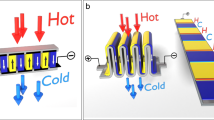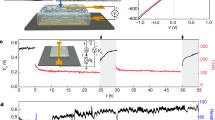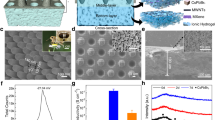Abstract
Environmentally adaptive power generation is attractive for the development of next-generation energy sources. Here we develop a heterogeneous moisture-enabled electric generator (HMEG) based on a bilayer of polyelectrolyte films. Through the spontaneous adsorption of water molecules in air and induced diffusion of oppositely charged ions, one single HMEG unit can produce a high voltage of ~0.95 V at low (25%) relative humidity (RH), and even jump to 1.38 V at 85% RH. A sequentially aligned stacking strategy is created for large-scale integration of HMEG units, to offer a voltage of more than 1,000 V under ambient conditions (25% RH, 25 °C). Using origami assembly, a small section of folded HMEGs renders an output of up to 43 V cm−3. Such integration devices supply sufficient power to illuminate a lamp bulb of 10 W, to drive a dynamic electronic ink screen and to control the gate voltage for a self-powered field effect transistor.
This is a preview of subscription content, access via your institution
Access options
Access Nature and 54 other Nature Portfolio journals
Get Nature+, our best-value online-access subscription
$29.99 / 30 days
cancel any time
Subscribe to this journal
Receive 12 print issues and online access
$259.00 per year
only $21.58 per issue
Buy this article
- Purchase on Springer Link
- Instant access to full article PDF
Prices may be subject to local taxes which are calculated during checkout






Similar content being viewed by others
Data availability
The data that support the findings of this paper are available from the corresponding authors upon reasonable request.
References
Xu, W. H. et al. A droplet-based electricity generator with high instantaneous power density. Nature 578, 392–396 (2020).
Liu, X. M. et al. Power generation from ambient humidity using protein nanowires. Nature 578, 550–554 (2020).
Xue, G. B. et al. Water-evaporation-induced electricity with nanostructured carbon materials. Nat. Nanotechnol. 12, 317–321 (2017).
Yin, J. et al. Generating electricity by moving a droplet of ionic liquid along graphene. Nat. Nanotechnol. 9, 378–383 (2014).
Cheng, H. H. et al. Spontaneous power source in ambient air of a well-directionally reduced graphene oxide bulk. Energy Environ. Sci. 11, 2839–2845 (2018).
Bai, J. X., Huang, Y. X., Cheng, H. H. & Qu, L. T. Moist-electric generation. Nanoscale 11, 23083–23091 (2019).
Xu, T., Han, Q., Cheng, Z. H., Zhang, J. & Qu, L. T. Interactions between graphene-based materials and water molecules toward actuator and electricity-generator applications. Small Methods 2, 1800108 (2018).
Zhao, F., Cheng, H. H., Zhang, Z. P., Jiang, L. & Qu, L. T. Direct power generation from a graphene oxide film under moisture. Adv. Mater. 27, 4351–4357 (2015).
Zhao, F., Liang, Y., Cheng, H. H., Jiang, L. & Qu, L. T. Highly efficient moisture-enabled electricity generation from graphene oxide frameworks. Energy Environ. Sci. 9, 912–916 (2016).
Zhao, F., Wang, L. X., Zhao, Y., Qu, L. T. & Dai, L. M. Graphene oxide nanoribbon assembly toward moisture powered information storage. Adv. Mater. 29, 1604972 (2017).
Li, M. J. et al. Biological nanofibrous generator for electricity harvest from moist air flow. Adv. Funct. Mater. 29, 1901798 (2019).
Xue, J. L. et al. Vapor-activated power generation on conductive polymer. Adv. Funct. Mater. 26, 8784–8792 (2016).
Huang, Y. X. et al. Interface-mediated hygroelectric generator with an output voltage approaching 1.5 volts. Nat. Commun. 9, 4166 (2018).
Xu, T. et al. An efficient polymer moist-electric generator. Energy Environ. Sci. 12, 972–978 (2019).
Huang, Y. X. et al. All-region-applicable, continuous power supply of graphene oxide composite. Energy Environ. Sci. 12, 1848–1856 (2019).
Catannia, K. C. Leaping eels electrify threats, supporting Humboldt’s account of a battle with horses. Proc. Natl Acad. Sci. USA 113, 6979–6984 (2016).
Wu, C. S. et al. Electrohydrodynamic jet printing driven by a triboelectric nanogenerator. Adv. Funct. Mater. 29, 1901102 (2019).
Li, A. Y., Zi, Y. L., Guo, H. Y., Wang, Z. L. & Fernández, F. M. Triboelectric nanogenerators for sensitive nano-coulomb molecular mass spectrometry. Nat. Nanotechnol. 12, 481–487 (2017).
Latorre, R. & Hall, J. E. Dipole potential measurements in asymmetric membranes. Nature 264, 361–363 (1976).
Gurtovenko, A. A. & Vattulainen, I. Lipid transmembrane asymmetry and intrinsic membrane potential: two sides of the same coin. J. Am. Chem. Soc. 129, 5358–5359 (2007).
Ma, Y. Q., Poole, K., Goyette, J. & Gaus, Katharina Introducing membrane charge and membrane potential to T cell signaling. Front. Immunol. 8, 1513 (2017).
Wang, H. Y. et al. Transparent, self-healing, arbitrary tailorable moist-electric film generator. Nano Energy 67, 104238 (2020).
Cayre, O. J., Chang, S. T. & Velev, O. D. Polyelectrolyte diode: nonlinear current response of a junction between aqueous ionic gels. J. Am. Chem. Soc. 129, 10801–10806 (2007).
Hou, Y. et al. Flexible ionic diodes for low-frequency mechanical energy harvesting. Adv. Energy Mater. 7, 1601983 (2017).
Guo, B. W. et al. Energy harvesting with single-ion-selective nanopores: a concerntration-gradient-driven nanofluidic power source. Adv. Funct. Mater. 20, 1339–1344 (2010).
Dotelli, G., Pelosato, R., Zampori, L. & Sora, I. N. LA-ICP-MS and EDS characterization of electrode/electrolyte interfaces in IT-SOFC materials. Appl. Phys. A 111, 887–896 (2013).
Kim, H. J., Chen, B. H., Suo, Z. G. & Hayward, R. C. Ionoelastomer junctions between polymer networks of fixed anions and cations. Science 367, 773–776 (2020).
Zhang, M. C. et al. Controllable ion transport by surface-charged graphene oxide membrane. Nat. Commun. 10, 1253 (2019).
Guo, W., Tian, Y. & Jiang, L. Asymmetric ion transport through ion-channel-mimetic solid-state nanopores. Acc. Chem. Res. 46, 2834–2846 (2013).
Liu, Q. et al. Asymmetric properties of ion transport in a charged conical nanopore. Phys. Rev. E 75, 051201 (2007).
Zhang, Z. et al. Mechanically strong MXene/Kevlar nanofiber composite membranes as high-performance nanofluidic osmotic power generators. Nat. Commun. 10, 2920 (2019).
Liang, Y. et al. Self-powered wearable graphene fiber for information expression. Nano Energy 32, 329–335 (2017).
Ding, T. P. et al. All‐printed porous carbon film for electricity generation from evaporation‐driven water flow. Adv. Funct. Mater. 27, 1700551 (2017).
Shen, D. Z. et al. Self-powered wearable electronics based on moisture enabled electricity generation. Adv. Mater. 30, 1705925 (2018).
Xu, T. et al. Electric power generation through the direct interaction of pristine graphene-oxide with water molecules. Small 14, 1704473 (2018).
Yang, C., Huang, Y. X., Cheng, H. H., Jiang, L. & Qu, L. T. Rollable, stretchable, and reconfigurable graphene hygroelectric generators. Adv. Mater. 31, 1805705 (2019).
Liang, Y. et al. Electric power generation via asymmetric moisturizing of graphene oxide for flexible, printable and portable electronics. Energy Environ. Sci. 11, 1730–1735 (2018).
Lee, S., Jang, H., Lee, H., Yoon, D. & Jeon, S. Direct fabrication of a moisture-driven power generator by laser-induced graphitization with a gradual defocusing method. ACS Appl. Mater. Interfaces 11, 26970–26975 (2019).
Schroeder, T. B. H. et al. An electric-eel-inspired soft power source from stacked hydrogels. Nature 552, 214–218 (2017).
Shao, C. X. et al. Large-scale production of flexible, high-voltage hydroelectric films based on solid oxides. ACS Appl. Mater. Interfaces 11, 30927–30935 (2019).
Gao, X. et al. Electric power generation by paper materials. J. Mater. Chem. A 7, 20574–20578 (2019).
Chen, N. et al. MEG actualized by high-valent metal carrier transport. Nano Energy 65, 104047 (2019).
Shao, C. X. et al. Wearable fiberform hygroelectric generator. Nano Energy 53, 698–705 (2018).
Li, J. et al. Surface functional modification boosts the output of an evaporation-driven water flow nanogenerator. Nano Energy 58, 797–802 (2019).
Bae, J., Yun, T. G., Suh, B. L., Kim, J. & Kim, I.-D. Self-operating transpiration-driven electrokinetic power generator with an artificial hydrological cycle. Energy Environ. Sci. 13, 527–534 (2020).
Yun, T. G., Bae, J., Rothschild, A. & Kim, I.-D. Transpiration driven electrokinetic power generator. ACS Nano 13, 12703–12709 (2019).
Das, S. S., Pedireddi, V. M., Bandopadhyay, A., Partha, S. & Chakraborthy, S. Electrical power generation from wet textile mediated by spontaneous nanoscale evaporation. Nano Lett. 19, 7191–7200 (2019).
Sun, J. C. et al. Electricity generation from a Ni-Al layered double hydroxide-based flexible generator driven by natural water evaporation. Nano Energy 57, 269–278 (2019).
Tian, J. L. et al. Surface charge density-dependent performance of Ni–Al layered double hydroxide-based flexible self-powered generators driven by natural water evaporation. Nano Energy 70, 104502 (2020).
Ji, J. Z. et al. Osmotic power generation with positively and negatively charged 2D nanofluidic membrane pairs. Adv. Funct. Mater. 27, 1603623 (2017).
Yang, P. F. et al. Batch production of 6-inch uniform monolayer molybdenum disulfide catalyzed by sodium in glass. Nat. Commun. 9, 979 (2018).
Acknowledgements
This work was supported by the National Key R&D Program of China (no. 2017YFB1104300), the National Science Foundation of China (nos. 22035005, 52022051, 22075165, 52073159 and 52090030), Tsinghua University Initiative Scientific Research Program (no. 2019Z08QCX08), NSFC-STINT (no. 21911530143), the State Key Laboratory of Tribology (no. SKLT2021B03) and Tsinghua-Foshan Innovation Special Fund (no. 2018THFS0412). This work is also supported by grant no. 2019GQG1025 from the Institute for Guo Qiang, Tsinghua University.
Author information
Authors and Affiliations
Contributions
L.Q., H.C. and H.W. designed the experiments. H.W., H.C. and T.H. performed the experiments. Y.H. conducted computational studies. H.W., Y.S., D.X., P.Y. and Y.Z. designed and characterized the self-powered FET. H.C. and C.L. gave advice on experiments. L.Q. and H.C. supervised the entire project. All authors discussed the results and reviewed the manuscript.
Corresponding authors
Ethics declarations
Competing interests
The authors declare no competing interests.
Additional information
Peer review information Nature Nanotechnology thanks Guihua Yu and the other, anonymous, reviewer(s) for their contribution to the peer review of this work.
Publisher’s note Springer Nature remains neutral with regard to jurisdictional claims in published maps and institutional affiliations.
Supplementary information
Supplementary Information
Supplementary Figs. 1–33, Discussion and Tables 1–6.
Supplementary Video 1
Integration of HMEG units by the sequentially aligned stacking method.
Supplementary Video 2
Dynamic electronic ink screen powered by integrated HMEGs.
Rights and permissions
About this article
Cite this article
Wang, H., Sun, Y., He, T. et al. Bilayer of polyelectrolyte films for spontaneous power generation in air up to an integrated 1,000 V output. Nat. Nanotechnol. 16, 811–819 (2021). https://doi.org/10.1038/s41565-021-00903-6
Received:
Accepted:
Published:
Issue Date:
DOI: https://doi.org/10.1038/s41565-021-00903-6
This article is cited by
-
Electricity generation from carbon dioxide adsorption by spatially nanoconfined ion separation
Nature Communications (2024)
-
Sustainable moisture energy
Nature Reviews Materials (2024)
-
A high-current hydrogel generator with engineered mechanoionic asymmetry
Nature Communications (2024)
-
Nature-inspired interfacial engineering for energy harvesting
Nature Reviews Electrical Engineering (2024)
-
Sensitive humidity sensor based on moisture-driven energy generation
Nano Research (2024)



